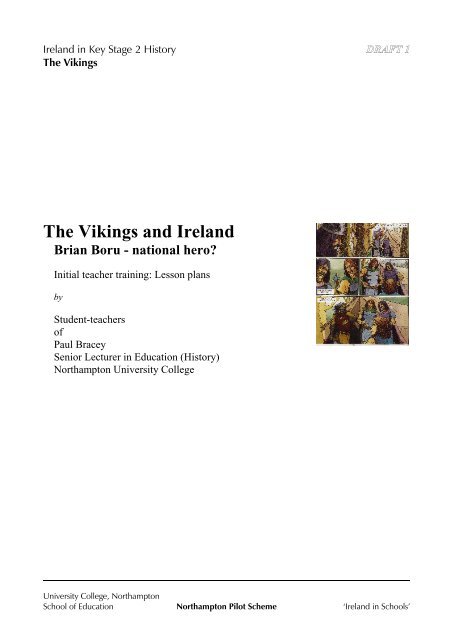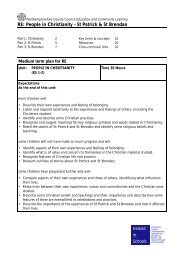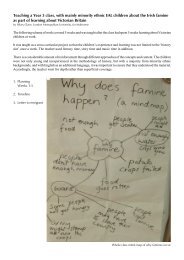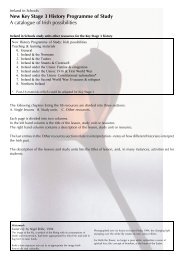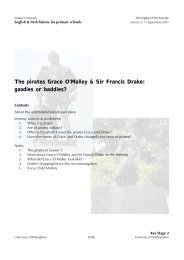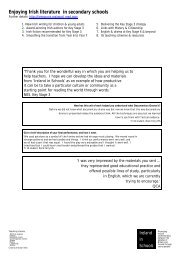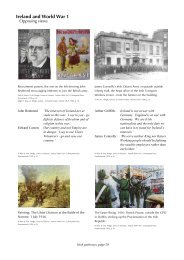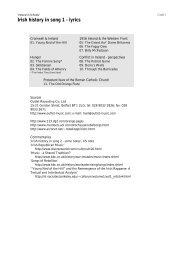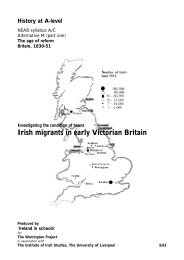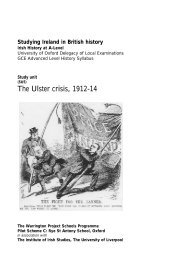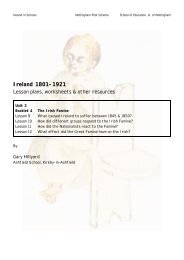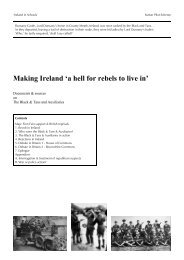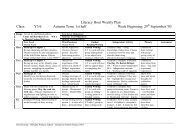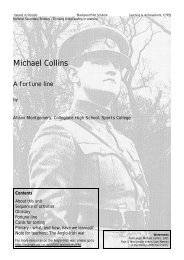Brian Boru & the Vikings - Ireland in Schools
Brian Boru & the Vikings - Ireland in Schools
Brian Boru & the Vikings - Ireland in Schools
Create successful ePaper yourself
Turn your PDF publications into a flip-book with our unique Google optimized e-Paper software.
<strong>Ireland</strong> <strong>in</strong> Key Stage 2 History<br />
The <strong>Vik<strong>in</strong>gs</strong><br />
The <strong>Vik<strong>in</strong>gs</strong> and <strong>Ireland</strong><br />
<strong>Brian</strong> <strong>Boru</strong> - national hero<br />
Initial teacher tra<strong>in</strong><strong>in</strong>g: Lesson plans<br />
by<br />
Student-teachers<br />
of<br />
Paul Bracey<br />
Senior Lecturer <strong>in</strong> Education (History)<br />
Northampton University College<br />
University College, Northampton<br />
School of Education Northampton Pilot Scheme ’<strong>Ireland</strong> <strong>in</strong> <strong>Schools</strong>
Contents<br />
Introduction<br />
Lesson plan 1: <strong>Brian</strong> <strong>Boru</strong><br />
Sources<br />
Examples of children•s responses<br />
Lesson plan 2: <strong>Brian</strong> <strong>Boru</strong> - a hero<br />
Sources
Introduction<br />
UCN, <strong>Brian</strong> <strong>Boru</strong> - national hero, page 1
Lesson plan 1 - <strong>Brian</strong> <strong>Boru</strong>: character and achievements<br />
Date: 14/06/00 Year Group: 6<br />
Group size: <br />
Location of Group: Tables<br />
Ma<strong>in</strong> Subject Focus: The <strong>Vik<strong>in</strong>gs</strong> - The character and achievements of <strong>Brian</strong> <strong>Boru</strong><br />
Learn<strong>in</strong>g objectives<br />
To use and compare different texts to ga<strong>in</strong> an <strong>in</strong>terpretation of <strong>Brian</strong> <strong>Boru</strong> and <strong>the</strong> Battle of Clontarf.<br />
Previous knowledge<br />
<strong>Vik<strong>in</strong>gs</strong>, where <strong>the</strong>y came from, <strong>the</strong> aspect of raiders and killers.<br />
Teach<strong>in</strong>g and learn<strong>in</strong>g strategies<br />
‘ Whole class <strong>in</strong>troduction (10 m<strong>in</strong>s), after which <strong>the</strong> children are separated <strong>in</strong>to small groups<br />
‘ Ma<strong>in</strong> task (45 m<strong>in</strong>s)<br />
(1st part):<br />
Children read different texts as group. Pick <strong>in</strong>dividual children to read.<br />
Discuss what <strong>the</strong>y have found from <strong>the</strong> texts. Do <strong>the</strong>y th<strong>in</strong>k <strong>the</strong> sources are true. Is <strong>the</strong> text<br />
<strong>in</strong>formative<br />
Give children question cards. True/false, reason<strong>in</strong>gs and evidence for <strong>the</strong>ir ideas<br />
(2nd part):<br />
Children make up <strong>the</strong>ir own questions. Comparison - discussion of K<strong>in</strong>g Alfred. With o<strong>the</strong>r<br />
group. Discuss <strong>the</strong>ir own ideas.<br />
Vocabulary<br />
<strong>Brian</strong> <strong>Boru</strong><br />
K<strong>in</strong>g Alfred<br />
<strong>Vik<strong>in</strong>gs</strong><br />
Ard-Ri<br />
Felled<br />
Foreigners<br />
Pagan<br />
Brodir<br />
Evidence<br />
Victorious.<br />
Resources<br />
Question sheets<br />
Text sheets<br />
Cartoon sheets x 2<br />
Dictionaries.<br />
Differentiation<br />
To observe <strong>the</strong> children and differentiate appropriately.<br />
Plenary<br />
In front of whole class, discuss <strong>the</strong>ir ideas and f<strong>in</strong>d<strong>in</strong>gs.<br />
UCN, <strong>Brian</strong> <strong>Boru</strong> - national hero, page 2
Question card<br />
Read and discuss <strong>the</strong> different sections of text.<br />
Decide whe<strong>the</strong>r <strong>the</strong>y support or oppose each of <strong>the</strong> follow<strong>in</strong>g statements.<br />
Th<strong>in</strong>k about your answers and decide why you th<strong>in</strong>k this and what evidence <strong>the</strong>re is<br />
to support your ideas.<br />
1. <strong>Brian</strong> <strong>Boru</strong>•s religion was an important aspect <strong>in</strong> his life.<br />
2. The Battle of Clontarf is <strong>the</strong> most important battle because <strong>the</strong> Irish defeated <strong>the</strong><br />
<strong>Vik<strong>in</strong>gs</strong>.<br />
3. Dur<strong>in</strong>g <strong>the</strong> Battle of Clontarf <strong>Brian</strong> was a ferocious fighter.<br />
4. <strong>Brian</strong> was a young warrior who fought for his country•s rights.<br />
5. <strong>Brian</strong> died bravely dur<strong>in</strong>g <strong>the</strong> battle as he fought <strong>the</strong> <strong>Vik<strong>in</strong>gs</strong>.<br />
UCN, <strong>Brian</strong> <strong>Boru</strong> - national hero, page 3
Source 1<br />
Morgan Llywelyn & Michael Scott, <strong>Ireland</strong>. A Graphic History, Element, Dorset 1995<br />
I N T R O D U C T I O N<br />
In <strong>the</strong> tenth century an obscure Irish chiefta<strong>in</strong> from <strong>the</strong> banks of <strong>the</strong><br />
Shannon made his reputation fight<strong>in</strong>g <strong>Vik<strong>in</strong>gs</strong>, <strong>the</strong>n rose to become k<strong>in</strong>g of<br />
<strong>the</strong> prov<strong>in</strong>ce of Munster and ultimately High K<strong>in</strong>g. In <strong>the</strong> Book of Armagh,<br />
<strong>Brian</strong> <strong>Boru</strong> would one day style himself Emperor of <strong>the</strong> Irish.<br />
<strong>Ireland</strong> had never seen anyth<strong>in</strong>g like him. He was an exceptional<br />
comb<strong>in</strong>ation of warrior and statesman, a pragmatic strategist who studied<br />
<strong>the</strong> careers of Caesar and Charlemagne, and won as many battles through<br />
psychology as with <strong>the</strong> sword. He also loved poetry and played <strong>the</strong> harp.<br />
Dur<strong>in</strong>g <strong>the</strong> course of his long life he had several wives and more than thirty<br />
concub<strong>in</strong>es, and marriages which he arranged for his children passed his<br />
blood <strong>in</strong>to <strong>the</strong> royal houses of Europe.<br />
<strong>Brian</strong> <strong>Boru</strong> was <strong>the</strong> first to envision an <strong>Ireland</strong> <strong>in</strong> which <strong>the</strong> various peoples<br />
would flow toge<strong>the</strong>r like many streams to form one river. With subtle<br />
diplomacy he made allies among <strong>the</strong> <strong>Vik<strong>in</strong>gs</strong> who had been his enemies<br />
and encouraged <strong>the</strong>m to become part of Irish society. Dur<strong>in</strong>g his reign as<br />
High K<strong>in</strong>g <strong>the</strong> island enjoyed an era of relative peace and prosperity. He<br />
even planned <strong>the</strong> establishment of a royal dynasty that would carry his<br />
vision for <strong>Ireland</strong> <strong>in</strong>to <strong>the</strong> future.<br />
Then <strong>in</strong> 1014, rebellion. <strong>Brian</strong> had set aside his troublesome wife<br />
Gormlaith, a pr<strong>in</strong>cess of Le<strong>in</strong>ster. By an earlier marriage to a Vik<strong>in</strong>g she<br />
was mo<strong>the</strong>r to Sitric Sillbeard, Vik<strong>in</strong>g k<strong>in</strong>g of Dubl<strong>in</strong>. Gormlaith and her<br />
bro<strong>the</strong>r Maehnora encouraged Sitric to call allies from throughout<br />
Scand<strong>in</strong>avia to overthrow <strong>Brian</strong> and complete <strong>the</strong> conquest of <strong>Ireland</strong>. Sitric<br />
actually offered his mo<strong>the</strong>r <strong>in</strong> marriage to any northman who killed <strong>Brian</strong><br />
<strong>Boru</strong>.<br />
A giant of a man <strong>in</strong> his seventy third year, <strong>Brian</strong> <strong>Boru</strong> rode to battle for <strong>the</strong><br />
last time. At <strong>the</strong> fish<strong>in</strong>g weir of Clontarf, north of Dubl<strong>in</strong>, his Irish and<br />
Vik<strong>in</strong>g allies fought <strong>the</strong> rebellious Le<strong>in</strong>stermen and an <strong>in</strong>vasion force of<br />
<strong>the</strong>ir Vik<strong>in</strong>g allies. At <strong>the</strong> end of that fateful Good Friday <strong>Brian</strong> had won,<br />
and <strong>the</strong> threat of foreign dom<strong>in</strong>ation was destroyed ... but at a terrible cost.<br />
UCN, <strong>Brian</strong> <strong>Boru</strong> - national hero, page 4
UCN, <strong>Brian</strong> <strong>Boru</strong> - national hero, page 5
UCN, <strong>Brian</strong> <strong>Boru</strong> - national hero, page 6
UCN, <strong>Brian</strong> <strong>Boru</strong> - national hero, page 7
Source 2<br />
The Battle of Clontarf web site on www.okelly.net/battles/boru.htm<br />
The battle was scheduled for Good Friday, 1014 AD.<br />
<strong>Brian</strong> felt much grieved that a day so sacred to <strong>the</strong> Christians should have been dest<strong>in</strong>ed<br />
for <strong>the</strong> work of death; but with dauntless spirit and a calm and confident exterior he issued<br />
orders for arrang<strong>in</strong>g troops <strong>in</strong> order of battle.<br />
Source 3<br />
The Battle of Clontarf web site on www.okelly.net/battles/boru.htm<br />
The result of <strong>the</strong> battle. (Do you th<strong>in</strong>k it is true)<br />
The battle was so fierce that it is said that <strong>in</strong> places <strong>the</strong> trees wept blood and <strong>the</strong> nearby<br />
River Tolka turned red.<br />
Source 4<br />
The Lion of <strong>Ireland</strong>: <strong>Brian</strong> of <strong>the</strong> Tributes web site on www.m<strong>in</strong>dspr<strong>in</strong>g.com/~cc003636/boru.html<br />
The Battle of Clontarf.<br />
The Battle of Clontarf was fought on holy day, Good Friday, and <strong>the</strong> battle lasted from<br />
early morn<strong>in</strong>g to <strong>the</strong> sett<strong>in</strong>g sun. <strong>Brian</strong> was too old to fight, but he appeared before his<br />
troops to <strong>in</strong>spire <strong>the</strong>m to <strong>the</strong>ir duty <strong>in</strong> <strong>the</strong> early morn<strong>in</strong>g. Throughout <strong>the</strong> day, <strong>Brian</strong><br />
prayed <strong>in</strong> his tent.... A flee<strong>in</strong>g Vik<strong>in</strong>g chief, Brodar of <strong>the</strong> Isle of Man, came upon <strong>Brian</strong>‘s<br />
tent and slay<strong>in</strong>g several body guards, he cleved <strong>the</strong> bare head of <strong>the</strong> Ard-Ri of <strong>Ireland</strong> while<br />
he was pray<strong>in</strong>g thanks <strong>in</strong> his tent. But Brodar was captured later and died a most hideous<br />
death.<br />
Source 5<br />
Morgan Llywelyn, <strong>Brian</strong> <strong>Boru</strong>, O Brien Press, Dubl<strong>in</strong> 1990<br />
The Battle of Clontarf, 1014 AD.<br />
Brodir of Man was runn<strong>in</strong>g wildly through Tomar‘s Wood ... He was <strong>the</strong> last <strong>in</strong>vad<strong>in</strong>g<br />
warlord left alive.<br />
Soon Brodir, mad with fear, would stumble across a lea<strong>the</strong>r tent and a tall, white-haired<br />
old man who still had his sword.<br />
Nei<strong>the</strong>r would live to see <strong>the</strong> first star.<br />
But <strong>Brian</strong> did not know this as he stood listen<strong>in</strong>g to <strong>the</strong> last sounds of <strong>the</strong> battle. He knew<br />
only that Murcha [his son] was dead, and that his army had won a mighty victory. Never<br />
aga<strong>in</strong> would <strong>the</strong> <strong>Vik<strong>in</strong>gs</strong> try to take <strong>Ireland</strong> by force.<br />
UCN, <strong>Brian</strong> <strong>Boru</strong> - national hero, page 8
Source 6<br />
Liam de Paor (ed.), ’<strong>Brian</strong> <strong>Boru</strong> and <strong>the</strong> Battle of Clontarf , Milestones <strong>in</strong> Irish History<br />
The Battle at Clontarf was not a struggle between <strong>the</strong> Irish and <strong>the</strong> <strong>Vik<strong>in</strong>gs</strong> for <strong>the</strong><br />
sovereignty of <strong>Ireland</strong>. Nei<strong>the</strong>r was it a great national victory which broke <strong>the</strong> power of<br />
<strong>the</strong> <strong>Vik<strong>in</strong>gs</strong> forever. Clontarf was part of <strong>the</strong> <strong>in</strong>ternal struggle for sovereignty between <strong>the</strong><br />
great Irish prov<strong>in</strong>cial rulers and it was <strong>in</strong> essence <strong>the</strong> revolt of <strong>the</strong> Le<strong>in</strong>stermen aga<strong>in</strong>st<br />
dom<strong>in</strong>ance from Munster, a revolt <strong>in</strong> which <strong>the</strong> Vik<strong>in</strong>g allies played a very important but<br />
secondary role.<br />
Source 7<br />
The Battle of Clontarf web site on www.okelly.net/battles/boru.htm<br />
However, that illustrious, all-victorious k<strong>in</strong>g, fell [was killed] by <strong>the</strong> foreigners [<strong>Vik<strong>in</strong>gs</strong>],<br />
<strong>in</strong> his eighty-eighth [88th] year of his age, and <strong>in</strong> <strong>the</strong> thirty-eighth [38th] year of his reign<br />
[as k<strong>in</strong>g], <strong>in</strong> Mumha<strong>in</strong>; and <strong>in</strong> his twelfth year as <strong>the</strong> chief sovereignty [ruler] of Er<strong>in</strong>n.<br />
The boy Tadk threw up an arm to protect <strong>Brian</strong>, but <strong>the</strong> sword cut off <strong>the</strong> arm and <strong>the</strong><br />
K<strong>in</strong>g's head. The K<strong>in</strong>g's blood spilled over <strong>the</strong> stump of <strong>the</strong> boy's arm, and <strong>the</strong> wound<br />
healed at once. Then Brodir shouted, álet <strong>the</strong> word go round that Brodir has felled [killed]<br />
K<strong>in</strong>g <strong>Brian</strong>.‘<br />
<strong>Brian</strong> himself <strong>the</strong>n became <strong>in</strong> story what he never was <strong>in</strong> fact, <strong>the</strong> defender of <strong>Ireland</strong><br />
aga<strong>in</strong>st <strong>the</strong> pagan hordes of <strong>Vik<strong>in</strong>gs</strong>, <strong>the</strong> saviour of Christianity, <strong>the</strong> sovereign ruler of<br />
<strong>Ireland</strong> who led <strong>the</strong> forces of <strong>the</strong> nation to victory over <strong>the</strong> foreigners. And that, of course,<br />
is how he is remembered <strong>in</strong> popular tradition.<br />
UCN, <strong>Brian</strong> <strong>Boru</strong> - national hero, page 9
Responses<br />
UCN, <strong>Brian</strong> <strong>Boru</strong> - national hero, page 10
Jamie<br />
1. True, because <strong>the</strong> battle was scheduled for<br />
Good Friday. (A Holy Day.) Which he didn t<br />
like. Also because he was pray<strong>in</strong>g <strong>in</strong> battle.<br />
2. False, because <strong>the</strong> Irish were fight<strong>in</strong>g<br />
<strong>the</strong>mselves.<br />
3. False, because he was to old to fight.<br />
4. False, because he was an old man that<br />
prayed <strong>in</strong> his tent.<br />
5. True, because he died fight<strong>in</strong>g and didn t<br />
run away. Consider<strong>in</strong>g his age he was very<br />
brave.<br />
Jade<br />
1. True. The Battle was fought on Good<br />
Friday.<br />
2. False. The Battle of clontarf was not a<br />
struggle between <strong>the</strong> Irish and <strong>the</strong> <strong>Vik<strong>in</strong>gs</strong>.<br />
3. False. He was 88 and he sat <strong>in</strong> his tent.<br />
4. False. He had his head cut of by his tent.<br />
5 False. He dided by have<strong>in</strong>g his head cut off.<br />
Anon<br />
1. <strong>Brian</strong> s religion was an important aspect of<br />
his life because <strong>the</strong> Christians fought <strong>the</strong><br />
Pagans. This is proved because <strong>the</strong>y fought<br />
on good friday.<br />
2. The battle wasn t <strong>the</strong> most important<br />
because we know that <strong>the</strong> Irish were<br />
fight<strong>in</strong>g aga<strong>in</strong>st <strong>the</strong> o<strong>the</strong>r Irish rulers.<br />
3. <strong>Brian</strong> wasn t a ferocious fighter because he<br />
was 88 and was pray<strong>in</strong>g <strong>in</strong> his tent.<br />
4. <strong>Brian</strong> wasn t young he as 88! He didn t fight<br />
for his countries rights he fought for his<br />
religion.<br />
Paul<br />
1. True. The battle was scheduled from good<br />
friday 1014 AD.<br />
2. False because one of <strong>the</strong> texts is written<br />
like a story and <strong>the</strong> o<strong>the</strong>r text has more<br />
facts <strong>in</strong> it.<br />
3. False because he was <strong>in</strong> his tent and was<br />
eighty eight.<br />
4. False because he was very old.<br />
5. False because he stayed <strong>in</strong> <strong>the</strong> tent and he<br />
got his head cut off and he didn t die<br />
bravely. He didn t die bravely because he<br />
just stood <strong>the</strong>re because he was to old to<br />
run or fight.<br />
Laurence<br />
1. True because <strong>the</strong> battle was scheduled for<br />
good friday, a holy day. Which he didn t<br />
like. Also because he was pray<strong>in</strong>g all<br />
through <strong>the</strong> battle.<br />
2. False because <strong>the</strong> battle was between <strong>the</strong><br />
Irish and <strong>the</strong> Irish.<br />
3. False because he was 88 and too old to<br />
fight.<br />
4. False because he was 88 and didn t fight any<br />
more.<br />
5. False. We found out that some of <strong>the</strong><br />
legend about <strong>Brian</strong> <strong>Boru</strong> was truce once but<br />
most of it says he is brave and he really<br />
isn t that brave. I don t th<strong>in</strong>k he died<br />
bravely because he did not try and defend<br />
himself.<br />
Ben<br />
1. True, because he was unhappy that <strong>the</strong><br />
battle was scheduled on good Friday and he<br />
didn t like it.<br />
2. False, because <strong>the</strong>y were actually fight<strong>in</strong>g<br />
because of each o<strong>the</strong>r different religions.<br />
3. False, because it says he sat <strong>in</strong> his tent<br />
pray<strong>in</strong>g.<br />
4. True, because <strong>in</strong> <strong>the</strong> text it says he issued<br />
orders etc.<br />
UCN, <strong>Brian</strong> <strong>Boru</strong> - national hero, page 11
Lesson plan 2 - <strong>Brian</strong> <strong>Boru</strong>: a national hero<br />
Date: 15/06/00 Year Group: 6<br />
Group size: 6<br />
Location of Group: Tables<br />
Ma<strong>in</strong> Subject Focus: The <strong>Vik<strong>in</strong>gs</strong> - Was <strong>Brian</strong> <strong>Boru</strong> a hero<br />
Learn<strong>in</strong>g objectives<br />
‘ To learn about <strong>Brian</strong> <strong>Boru</strong> and <strong>the</strong> Battle of Clontarf. (Hi8a/b)<br />
‘ To use a range of historical sources as a form of evidence for and aga<strong>in</strong>st <strong>Boru</strong> be<strong>in</strong>g a hero. (Hi4a/b)<br />
Strategies<br />
Tim<strong>in</strong>gs<br />
‘ Whole class <strong>in</strong>troduction (10 m<strong>in</strong>s).<br />
‘ Group <strong>in</strong>troduction (10 m<strong>in</strong>s).<br />
‘ Ma<strong>in</strong> task (1 St part) - Def<strong>in</strong><strong>in</strong>g a hero, <strong>in</strong>troduc<strong>in</strong>g <strong>the</strong> range of sources, children putt<strong>in</strong>g toge<strong>the</strong>r<br />
evidence for and aga<strong>in</strong>st (40 m<strong>in</strong>s).<br />
‘ Ma<strong>in</strong> task (2nd part) - Discuss/collat<strong>in</strong>g as a group evidence, refer evidence to question: Was <strong>Brian</strong><br />
a hero - discuss as a group, children to design Wanted• or Hero• poster (40 m<strong>in</strong>s).<br />
Teach<strong>in</strong>g Strategies<br />
‘ Group <strong>in</strong>troduction and overview of <strong>the</strong> Battle of Clontarf.<br />
Key questions: Who was <strong>Brian</strong> <strong>Boru</strong> What did he do What happened at <strong>the</strong> Battle of Clontarf<br />
‘ Ascerta<strong>in</strong> children's knowledge and understand<strong>in</strong>g of a hero. Key questions:<br />
What is a hero<br />
Who is a hero<br />
Why are <strong>the</strong>y a hero<br />
‘ Def<strong>in</strong>ition of a hero.<br />
‘ Introduce different sources of <strong>in</strong>formation.<br />
‘ Discuss as a group how <strong>the</strong> different sources can be used. Key questions:<br />
What do <strong>the</strong>y show us<br />
What can we see from <strong>the</strong> different sources<br />
How might <strong>the</strong>y be biased towards one side<br />
‘ Expla<strong>in</strong> task - us<strong>in</strong>g sources to ga<strong>the</strong>r evidence for <strong>the</strong> case aga<strong>in</strong>st <strong>Boru</strong> be<strong>in</strong>g a hero and <strong>the</strong> case<br />
for him be<strong>in</strong>g a hero.<br />
‘ Demonstrate to group us<strong>in</strong>g one source of evidence.<br />
‘ Children to work <strong>in</strong> pairs when ga<strong>the</strong>r<strong>in</strong>g evidence.<br />
‘ Children to record <strong>the</strong>ir f<strong>in</strong>d<strong>in</strong>gs on a worksheet.<br />
‘ Discuss as group f<strong>in</strong>d<strong>in</strong>gs.<br />
‘ Relate f<strong>in</strong>d<strong>in</strong>gs to question. Do <strong>the</strong> children th<strong>in</strong>k Born was a hero<br />
‘ Children to design a `Wanted' or `Hero' poster, detail<strong>in</strong>g evidence for <strong>the</strong>ir choice.<br />
Learn<strong>in</strong>g Strategies<br />
‘ Group <strong>in</strong>troduction to discuss task and ascerta<strong>in</strong> children's previous knowledge.<br />
‘ Question<strong>in</strong>g to encourage discussion and understand<strong>in</strong>g.<br />
UCN, <strong>Brian</strong> <strong>Boru</strong> - national hero, page 12
‘ Relate task e.g. What/who is a hero to children's own experiences.<br />
‘ Us<strong>in</strong>g different sources of <strong>in</strong>formation to ga<strong>the</strong>r evidence.<br />
‘ Encourag<strong>in</strong>g children to select relevant evidence from <strong>the</strong> different sources of <strong>in</strong>formation.<br />
‘ Children to demonstrate understand<strong>in</strong>g by record<strong>in</strong>g evidence for and aga<strong>in</strong>st <strong>Boru</strong> be<strong>in</strong>g a hero.<br />
‘ Relate task to ma<strong>in</strong> aim, group discussion - Was <strong>Brian</strong> a hero<br />
‘ Children to demonstrate <strong>the</strong>ir understand<strong>in</strong>g by produc<strong>in</strong>g a poster.<br />
Resources<br />
Various sources of <strong>in</strong>formation.<br />
Sheet for record<strong>in</strong>g evidence.<br />
Sugar paper.<br />
Pla<strong>in</strong> paper.<br />
Pens.<br />
Assessment<br />
Observation.<br />
Question<strong>in</strong>g.<br />
Poster.<br />
Differentiation<br />
Extra adult support.<br />
UCN, <strong>Brian</strong> <strong>Boru</strong> - national hero, page 13
Prompt sheet<br />
When research<strong>in</strong>g you may wish to th<strong>in</strong>k about <strong>the</strong> follow<strong>in</strong>g areas:<br />
What was <strong>Ireland</strong> like <strong>in</strong> <strong>Boru</strong> s time (Background)<br />
How did <strong>Boru</strong> become High K<strong>in</strong>g<br />
What did <strong>Boru</strong> do whilst he was High K<strong>in</strong>g How did he die<br />
What type of person was <strong>Boru</strong><br />
UCN, <strong>Brian</strong> <strong>Boru</strong> - national hero, page 14
Source 1<br />
Morgan Llywelyn & Michael Scott, <strong>Ireland</strong>. A Graphic History, Element, Dorset 1995<br />
See pages 4-7 above.<br />
UCN, <strong>Brian</strong> <strong>Boru</strong> - national hero, page 15
Source 2<br />
Morgan Llywelyn, <strong>Brian</strong> <strong>Boru</strong>, O Brien Press, Dubl<strong>in</strong> 1990<br />
<strong>Brian</strong> <strong>Boru</strong> grow up <strong>in</strong> an <strong>Ireland</strong> torn by wars - chiefta<strong>in</strong> aga<strong>in</strong>st chiefta<strong>in</strong>, tribe aga<strong>in</strong>st<br />
tribe - and devastated by <strong>the</strong> <strong>Vik<strong>in</strong>gs</strong>. As a boy, <strong>Brian</strong> wanted to be a mighty warrior, and<br />
when his family were massacred by <strong>the</strong> <strong>Vik<strong>in</strong>gs</strong>, his only aim was to defeat <strong>the</strong>se enemies<br />
forever. But <strong>Brian</strong> was not just a fearless fighter, he was a clever, educated man. He<br />
learned <strong>the</strong> wars of his enemies and overcame opposition, prejudice and treachery to<br />
become High K<strong>in</strong>g of <strong>Ireland</strong>. In <strong>the</strong> famous Battle of Clontarf <strong>in</strong> 1014 <strong>Brian</strong> <strong>Boru</strong> f<strong>in</strong>ally<br />
conquered <strong>the</strong> Vik<strong>in</strong>g. It was his last act.<br />
Source 3<br />
Philippa W<strong>in</strong>gate and Anne Millard, The Vik<strong>in</strong>g World, <br />
In <strong>the</strong> eighth century, <strong>Ireland</strong> was a very prosperous country. It was divided <strong>in</strong>to several<br />
k<strong>in</strong>gdoms, but <strong>the</strong> k<strong>in</strong>gs were united under one leader called <strong>the</strong> High K<strong>in</strong>g. Irish<br />
monasteries had become <strong>the</strong> focus of learn<strong>in</strong>g and of great wealth and were a good target<br />
for <strong>the</strong> <strong>Vik<strong>in</strong>gs</strong>. Raiders first appeared <strong>in</strong> <strong>the</strong> 799s and carried out swift, vicious raids on<br />
isolated coastal villages and monasteries.<br />
In 839, <strong>the</strong> <strong>Vik<strong>in</strong>gs</strong> came <strong>in</strong> large numbers. Norwegian fleets arrived and <strong>the</strong> warriors built<br />
fortified camps where <strong>the</strong>y spent <strong>the</strong> w<strong>in</strong>ter. These camps grow <strong>in</strong>to <strong>Ireland</strong>‘s first cities<br />
such as Dubl<strong>in</strong>, Wexford, Waterford and Cork.<br />
Merchants from all over <strong>the</strong> Vik<strong>in</strong>g world came to buy and sell goods at <strong>the</strong> trad<strong>in</strong>g camps<br />
or long-phorts, br<strong>in</strong>g<strong>in</strong>g wealth to <strong>Ireland</strong>. The <strong>Vik<strong>in</strong>gs</strong> built Scand<strong>in</strong>avian style houses<br />
and craftsmen made goods <strong>in</strong>fluenced by Norse tastes. Many Norwegians married Irish<br />
women and settled <strong>in</strong> <strong>the</strong> towns and became farmers.<br />
The Irish tried many times to drive out <strong>the</strong> Vik<strong>in</strong>g <strong>in</strong>truders. Their best chance came at <strong>the</strong><br />
beg<strong>in</strong>n<strong>in</strong>g of <strong>the</strong> eleventh century.<br />
UCN, <strong>Brian</strong> <strong>Boru</strong> - national hero, page 16
Source 4<br />
<strong>Brian</strong> <strong>Boru</strong>, High K<strong>in</strong>g of <strong>Ireland</strong> web site on www.maui.net/~mauifun/bboru.htm<br />
<strong>Brian</strong> <strong>Boru</strong> was a Christian, he had battled <strong>the</strong> ancestors of <strong>the</strong><br />
O•Neills for many years and was <strong>the</strong> rebuilder of Vik<strong>in</strong>g-ravaged<br />
monasteries and churches, <strong>Boru</strong> also built forts, and at <strong>the</strong> age of 74<br />
he commanded an army of thousands, he battled royally aga<strong>in</strong>st <strong>the</strong><br />
Vik<strong>in</strong>g soldiers, his army slay<strong>in</strong>g some 7000 <strong>Vik<strong>in</strong>gs</strong>.<br />
In 1005 AD <strong>Boru</strong> reached Armagh, lead<strong>in</strong>g several armies from<br />
Munster, Le<strong>in</strong>ster, Meath, Connacht and Norse Dubl<strong>in</strong>. He had<br />
come to <strong>the</strong> North two times previously, only to be repelled by <strong>the</strong><br />
Ulster k<strong>in</strong>gs. The Church had recognized <strong>Boru</strong>•s claim to supremacy<br />
after he paid 20 ounces of gold to have <strong>the</strong> Church <strong>in</strong>scribe his name<br />
<strong>in</strong> <strong>the</strong> Book of Armagh as <strong>the</strong> Emperor of <strong>the</strong> Irish•. A year later he<br />
established his claim with a circuit around Ulster. But <strong>Brian</strong> had<br />
difficulties, <strong>the</strong> Le<strong>in</strong>ster and Dubl<strong>in</strong> armies called <strong>in</strong> allies from <strong>the</strong><br />
Vik<strong>in</strong>g world, creat<strong>in</strong>g <strong>the</strong> scenario for <strong>the</strong> battle that lead to <strong>Brian</strong>•s<br />
death.<br />
It was Good Friday <strong>in</strong> <strong>the</strong> year 1014, and <strong>the</strong> battle lasted from<br />
sunrise to sunset. The battle was called <strong>the</strong> Battle of Clontarf• and<br />
was also known as <strong>the</strong> Battle of <strong>Brian</strong>, and it ended <strong>the</strong> dom<strong>in</strong>ation<br />
of <strong>the</strong> Ui Neill, <strong>the</strong> ancestors of <strong>the</strong> O•Neill's of Tyrone and<br />
Clandeboye.<br />
<strong>Brian</strong> <strong>Boru</strong> was killed <strong>in</strong> his tent, by K<strong>in</strong>g Brodar of Man, follow<strong>in</strong>g<br />
Clontarf, and 4000 o<strong>the</strong>r Irishmen also died that day, still K<strong>in</strong>g <strong>Brian</strong><br />
was considered triumphant. He was killed along with Sigurd, who<br />
was Earl of <strong>the</strong> Orkneys, <strong>the</strong> K<strong>in</strong>g of Le<strong>in</strong>ster, also two Connacht<br />
k<strong>in</strong>gs were sla<strong>in</strong>, and <strong>Brian</strong> <strong>Boru</strong>•s son, Murchadh were all killed<br />
along with many o<strong>the</strong>rs of noble blood.<br />
<strong>Brian</strong> <strong>Boru</strong><br />
An artists fictional render<strong>in</strong>g<br />
<strong>Brian</strong> <strong>Boru</strong> is remembered as one of <strong>the</strong> greatest hereos of all <strong>Ireland</strong><br />
because he ended any hope of <strong>the</strong> Vik<strong>in</strong>g•s ever captur<strong>in</strong>g <strong>Ireland</strong>.<br />
<strong>Brian</strong> <strong>Boru</strong> reportedly had 4 wives and 30 concub<strong>in</strong>es and many,<br />
many Irish families trace <strong>the</strong>ir ancestral heritage to <strong>Brian</strong> <strong>Boru</strong>.<br />
UCN, <strong>Brian</strong> <strong>Boru</strong> - national hero, page 17
Source 5<br />
<strong>Brian</strong> <strong>Boru</strong>, web site on www.sleep<strong>in</strong>g-giant.ie/bealick/boru.htm<br />
The Battle of Bealach Leachta, <strong>in</strong> 978, marked <strong>the</strong> first major defeat of <strong>the</strong> Danes <strong>in</strong><br />
<strong>Ireland</strong> and established <strong>Brian</strong> <strong>Boru</strong> as a serious contender for position of Ard Ri (High<br />
K<strong>in</strong>g) of <strong>Ireland</strong>.<br />
The battle was <strong>the</strong> climax of a power-struggle between <strong>the</strong> Dal gCais of North Munster and<br />
<strong>the</strong> Lords of Carbery. Mahon of <strong>the</strong> Dal gCais was captured by Imar, a Limerick Dane<br />
who was allied to <strong>the</strong> O‘Donovans and O‘Mahonys of Carbery. Imar delivered Mahon, a<br />
bro<strong>the</strong>r of <strong>Brian</strong> <strong>Boru</strong> of K<strong>in</strong>cora, <strong>in</strong>to <strong>the</strong> hands of Maolmuidh of <strong>the</strong> O‘Mahonys, who<br />
killed him at Aghabullogue.<br />
<strong>Brian</strong> <strong>Boru</strong> came seek<strong>in</strong>g revenge, first despatch<strong>in</strong>g Imar <strong>the</strong> Dane, <strong>the</strong>n pick<strong>in</strong>g off<br />
O‘Donovan, and <strong>the</strong>n meet<strong>in</strong>g <strong>the</strong> O‘Mahonys at Bealach Leachta. A fierce battle was<br />
waged all day on <strong>the</strong> riverside pla<strong>in</strong> - <strong>Brian</strong>'s army had swelled as many m<strong>in</strong>or chiefta<strong>in</strong>s<br />
began to recognise his potential, and Maolmuidh had <strong>the</strong> support of <strong>the</strong> rema<strong>in</strong>s of <strong>the</strong><br />
O‘Donovan clan and 1500 Danes.<br />
Maolmuidh and his troops were forced back, and Maolmuidh took refuge at Leacha Dubh<br />
(site of Macroom Golf Course), where he was found and killed. Fulfill<strong>in</strong>g a curse put on<br />
him for <strong>the</strong> assass<strong>in</strong>ation of Mahon, Maolmuidh is buried on <strong>the</strong> north side of <strong>the</strong> hill,<br />
where <strong>the</strong> sun never sh<strong>in</strong>es, under a harsh w<strong>in</strong>d.<br />
Follow<strong>in</strong>g <strong>the</strong> battle <strong>Brian</strong> <strong>Boru</strong> was crowned K<strong>in</strong>g of Munster. Three stand<strong>in</strong>g stones<br />
were erected on <strong>the</strong> site of <strong>the</strong> battle (of which two rema<strong>in</strong>). One is known as Leacht<br />
Mahon.<br />
UCN, <strong>Brian</strong> <strong>Boru</strong> - national hero, page 18
Source 6<br />
F. Donald Logan, The <strong>Vik<strong>in</strong>gs</strong> <strong>in</strong> History, Routledge, London 1983<br />
What, <strong>the</strong>n, of <strong>the</strong> Battle of Clontarf <strong>in</strong> 1014 Was this not <strong>the</strong> event by which <strong>Brian</strong> <strong>Boru</strong><br />
stopped <strong>the</strong> Vik<strong>in</strong>g threat once and for all and saved <strong>Ireland</strong> Legends die hard, and<br />
perhaps no legend will die harder than <strong>the</strong> legend of <strong>Brian</strong> <strong>Boru</strong> and <strong>the</strong> Battle of Clontarf,<br />
for <strong>the</strong>re are so many people <strong>in</strong> <strong>Ireland</strong> who claim descent from this legendary hero.<br />
As <strong>the</strong> legend would have it, <strong>Brian</strong> emerged from <strong>the</strong> fastnesses of deepest Clare as<br />
overk<strong>in</strong>g of <strong>the</strong> south and <strong>in</strong> time as High K<strong>in</strong>g of <strong>Ireland</strong>.... <strong>Brian</strong> stood tall as <strong>the</strong><br />
national leader to defeat <strong>the</strong> <strong>Vik<strong>in</strong>gs</strong>. It was at Clontarf north of <strong>the</strong> Liffey near Dubl<strong>in</strong>,<br />
that <strong>the</strong> Irish faced <strong>the</strong> <strong>Vik<strong>in</strong>gs</strong> and <strong>Brian</strong> Born faced Sihtric. The <strong>Vik<strong>in</strong>gs</strong> had summoned<br />
a mighty Vik<strong>in</strong>g army from virtually <strong>the</strong> whole Vik<strong>in</strong>g world.... On <strong>the</strong> eve of <strong>the</strong> battle<br />
omens were seen across <strong>the</strong> north as far away as Iceland.... The day of battle arrived on<br />
Good Friday, 1014; and <strong>Brian</strong>‘s Irish army, lack<strong>in</strong>g <strong>the</strong> Le<strong>in</strong>stermen, who had gone over<br />
to <strong>the</strong> Vik<strong>in</strong>g side ... <strong>Brian</strong> knelt on an animal sk<strong>in</strong> <strong>in</strong> Tomar‘s Wood and refused himself,<br />
to enter <strong>in</strong>to combat on this sacred day. Never<strong>the</strong>less, <strong>the</strong> battle went ahead. First, a<br />
champion from each side met, but with no decision. The forces of Munster <strong>the</strong>n fell back<br />
before onrush<strong>in</strong>g Le<strong>in</strong>ster. The remnants of <strong>the</strong> Vik<strong>in</strong>g army and <strong>the</strong> men of Le<strong>in</strong>ster were<br />
forced to flee <strong>the</strong>ir ships through a nearby wood. There <strong>the</strong>y saw an old man kneel<strong>in</strong>g<br />
among a circle of warriors. Brodir, K<strong>in</strong>g of isle of Man, asked who this man was, and he<br />
was told <strong>Brian</strong> <strong>Boru</strong>. Brodir raised his mighty battle sword and hit <strong>the</strong> High K<strong>in</strong>g of<br />
<strong>Ireland</strong>. The day was already lost, however, and <strong>the</strong> blood of <strong>Brian</strong> <strong>Boru</strong> sealed <strong>the</strong> victory<br />
of <strong>the</strong> Irish over <strong>the</strong> Vik<strong>in</strong>g. The Vik<strong>in</strong>g age had ended. Or, so <strong>the</strong> story goes.<br />
Is this fact or fiction<br />
From this tangle of fact and fiction some sift<strong>in</strong>g must be done. <strong>Brian</strong> <strong>Boru</strong> had <strong>in</strong>deed<br />
ga<strong>in</strong>ed control over <strong>the</strong> south and, at times over parts of <strong>the</strong> north. He did lead some Irish<br />
tribes (and even some Vik<strong>in</strong>g forces) at a battle at Clontarf on Good Friday <strong>in</strong> 1014.<br />
However, his ma<strong>in</strong> opposition was not <strong>the</strong> <strong>Vik<strong>in</strong>gs</strong>, it was <strong>the</strong> K<strong>in</strong>g of Le<strong>in</strong>ster, who had<br />
tried to ga<strong>in</strong> control over parts of <strong>Ireland</strong>. <strong>Brian</strong> <strong>Boru</strong>‘s forces were successful, but he fell<br />
<strong>in</strong> <strong>the</strong> battle. The struggle for control and peace <strong>in</strong> <strong>Ireland</strong> struggled for a 150 years after<br />
Clontarf, which was only one amongst many o<strong>the</strong>r battles. It did not destroy <strong>the</strong> power of<br />
<strong>the</strong> <strong>Vik<strong>in</strong>gs</strong>. Noth<strong>in</strong>g so simple as a one-day battle <strong>in</strong> <strong>the</strong> spr<strong>in</strong>g of 1014 could do that. The<br />
<strong>Vik<strong>in</strong>gs</strong> had already become part of <strong>the</strong> Irish society and were no longer a strong force at<br />
<strong>the</strong> time of <strong>the</strong> Battle of Clontarf.<br />
UCN, <strong>Brian</strong> <strong>Boru</strong> - national hero, page 19
Source 7<br />
Distribution of Scand<strong>in</strong>avian graves <strong>in</strong> <strong>the</strong> Vik<strong>in</strong>g Age <strong>in</strong> <strong>the</strong> British Isles<br />
UCN, <strong>Brian</strong> <strong>Boru</strong> - national hero, page 20


